The First Discovery
My Discovery in the Andes 2/12/2005
The following text was written by Ricardo shortly after his discovery in 2005.
Scroll to bottom of the page to see new afterword written on April 18, 2012.
I had just finished guiding Aconcagua, the highest peak in the western hemisphere at 22,841′ in the Argentinean Andes, but little did I know that I was
just beginning one of the most exciting adventures in my life.
I have always been fascinated by the story of the Uruguayan airplane crash that happened on October 13th, 1972. That was the beginning of an incredible ordeal; the survivors of the crash went through 72 days trapped on the mountain during which many of them died. The 16 survivors had to endure cold, the effects of altitude, avalanches, isolation, despair and starvation. The last of these they dealt with by having to eat the bodies of the dead. In the end, two of them breached the Andes and returned with helicopters to rescue the rest.
I had found out on my previous Aconcagua expedition that there was a way to reach the place where this event took place. So on this occasion I decided to extend my trip a few days and go explore that area.
On February 10, 2005 (my birthday!) I took a bus from Mendoza to El Sosneado, the nearest Argentinean village to the site of the accident. It was a 6-hour bus ride that took me farther south than I’d ever been. There I met Edgardo Barrios, the owner of the hostel and the person who offers transportation (4×4 and horses) to the site. Edgardo showed me a large collection of newspaper clippings and photographs of the area and the incident. As it turned out the survivors have visited the site on several occasions so Edgardo has met most, if not all, of the survivors. Edgardo and I discussed the plan for the next few days. I told Edgardo I wanted to explore the route that the survivors had taken on their way out, and he also mentioned that we could climb up to where the plane had crashed. We decided Mario Perez, one of his guides, would climb with me as far as he could and we talked about me going further alone if time permitted.
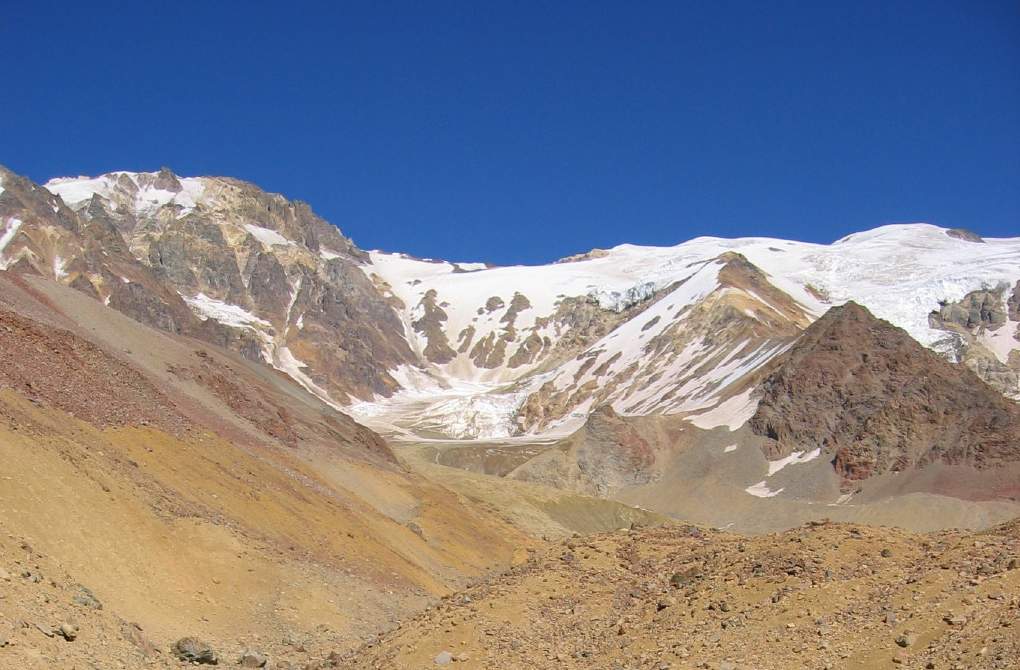
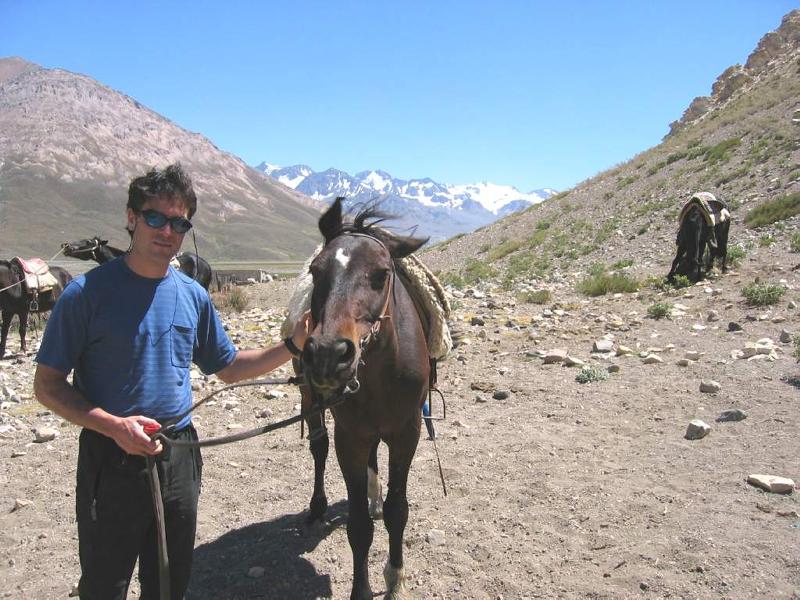
The next morning a group of Argentinean tourists and I left with Mario Perez on a 4×4 truck. It was about a 3-hour drive to a camp where we would meet the horses. This is where we entered the Andes. To our right we skirted the volcano “El Sosneado”, which is a very impressive peak that rises higher than 5000m (16400′). We ate lunch and we got on the horses for a 3-hour ride. It was quite strenuous! I never realized that riding horses could be so exhausting! You would think the horse would be doing all the exercise but it’s surprising how much energy it takes to stay on the horse over very rugged terrain!
We spent the night at another camp and prepared for the next day. The following morning Mario and I left early and traveled fast on the horses, which for an unexperienced rider like me was very tiring. At last, after more than 2 ½ hours, we made it to the valley.
Here it was, the place that I had imagined for so many years. No matter what the book says, it is quite a desolate place and still very far from any village. It is a huge valley surrounded on three sides by huge walls and peaks, all of them rising above 14,000ft. Only the side we came from is somewhat open. But from up there it is not obvious that it would make a good escape route, in fact, without horses and with snow it wouldn’t necessarily be the best way out since it is so far from anything.
There we found the memorial consisting of a pile of airplane parts and a cross. One of the parts still reads “FUE” from “Fuerza Aerea Uruguaya”. This was a plane chartered from the Uruguayan Air Force. This is a beautiful place! There are glaciers everywhere. This memorial is situated on a small rib of ground that is not exposed to avalanches and is not
glaciated. It is amazing to think that this is the place where the survivors lived for 72 days. They must have memorized many of the features of every peak around them from staring at them for hours on end! They mention in the book how they thought the place was beautiful but at the same time thought that hell could not have been any worse of a place to be.
Next to the memorial is the actual grave where the remains of the passengers that died during and after the accident lie. Another cross marks this spot.
After a few minutes there we decided to move on since we were limited on time. We made our way to just above the place where the fuselage had ended up and this is where the snow started. As we crossed rocks and snow we made our first discovery.

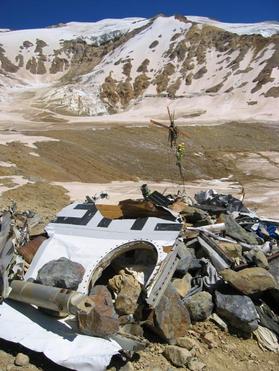
Mario found a piece of clear plastic (probably coming from the plastic of the airplane’s windows) obviously shaped into a tool, a knife of sorts. As I stared at this I told Mario, “Do you realize what this is?” Very likely a knife they carved to cut up the meat (human flesh in this case!).
I put that in my pack to bring it down to the memorial and we decided to explore the mountain above. Specifically we went up to find the place where the plane had crashed. We knew that people had photographed a propeller way up on the peak and that there may be parts up there as well as other undiscovered evidence. The terrain quickly steepened. I kicked in steps in the snow for Mario since he didn’t have an ice axe.
About an hour later we reached some exposed rocks and an area that flattened out. I knew that any flat area would be a natural deposit place for debris. Avalanches bring down snow, rocks and potentially debris on a yearly basis and would naturally deposit it at places like that so I began searching and, sure enough, I found some lightweight metal parts obviously belonging to the airplane. It was very exciting to see we were on the right track. We took some photographs and we continued on another field of penitentes (Penitentes are stalagmite-like ice formations that are common in the Andes due to the extremely dry conditions and intense solar radiation). These can create quite an obstacle. As we climbed between penitentes we punched through what seemed to be small crevasses. It was very hard to judge just how thick that small glacier was, and whether it presented any crevasse falling danger or not. We pressed on. At this point we reached a Y where the main gully continued up and to the left, and where another small and steep gully branched out to the right.
Here we discovered another airplane part. The thing that really attracted my attention was that it seemed to be laying at a point that would suggest it was coming from the right-hand steep gully, not the main gully where everyone had said the plane came down. This seemed very odd for two reasons.
First of all, you would think that by now they would have all this figured out; and second, the right-hand gully seemed impossibly steep and narrow. In spite of this, I suggested exploring that gully since it meant that if we found more parts up there it would change the whole theory of where the plane had crashed and slid. We kept climbing. The going got very tedious after the snow disappeared, since now we were trying to climb a slope of scree and rocks that was close to 45 degrees. Every step would set rocks rolling down.
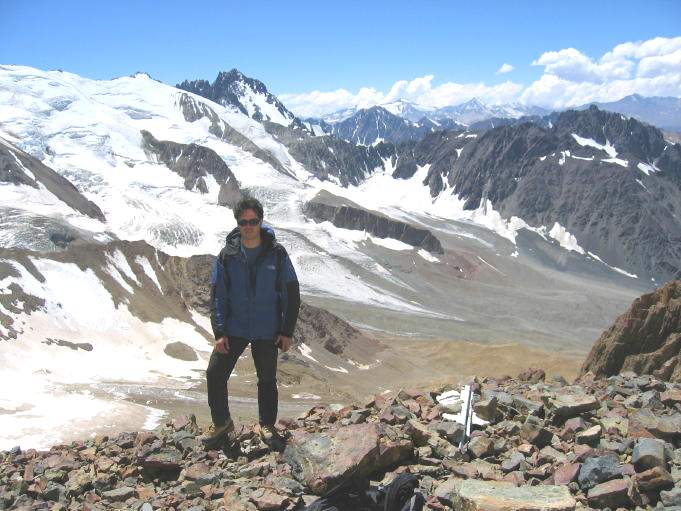

It was really a horrible route of ascent, but since we were trying to find evidence and not climb a peak, we had no choice but to follow that route. It took a lot of energy trying to make any progress in that kind of terrain while being above 14,400′. Just when I thought we would find nothing else I found in between two big penitentes (surrounded by rocks) a big metal part. This was the big evidence I was looking for. This was confirming my theory that we were on the path the plane slid down on.
The scree we were climbing got so loose it started to become dangerous. At one point a rock came loose and hit me right on my left shin. It was a very painful blow and I knew it had cut my skin but luckily it wasn’t a serious injury (though as I write this, 4 weeks later, my shin is still healing). As it appeared that we would reach the top of the saddle
without finding anything else…all of a sudden we reached a point where we found many metal parts scattered around. We found what looked like an oxygen tank or perhaps an old fire extinguisher from the plane. We found wire and then Mario showed me what he had in his hand…a used roll of film!! This all became unbelievable! We obviously had hit the spot where after the initial impact and breaking of the plane, the fuselage had made contact with the slope and began sliding down. There was so much debris in an area of about 20 by 20 yards! As we searched incredulously we also found a part of a camera, the frame of some sunglasses, a silver metal wristband for a watch and many airplane parts. As we examined all this and looked around our gaze stopped at a blue colored object and Mario said to me, “Are you seeing what I’m seeing?” We were speechless! A piece of blue clothing was sticking out of the rocks. It was a very strange sensation. Thoughts rushed thru my mind and I couldn’t help but wonder, “Are those human remains?” At this point I yelled at Mario: “Let’s photograph all this before we touch it! This is big!”
As I made my way up there I found a white article of clothing. When we removed the rocks we found it was a beige pair of corduroy pants with a leather belt still attached to them. We also found a shirt (that looked very 70’s I must say!) and a white sweater. Then I reached the blue piece of clothing and, after photographing it, I proceeded to uncover it.
I found no bones or human remains but as I pulled it out and realized it was a coat, I felt something weighing it down. In total disbelief I found that the inner pocket had a wallet and documents inside!
Mario took the camera and started taking pictures while I slowly and very
carefully started taking the wallet out. The inside was wet. I opened the wallet, and still wondering if I was dreaming, I saw a photo ID. It clearly said
“Eduardo Jose Strauch Urioste”. The photo was still visible. The ID was issued
in 1968. I found money inside the wallet! $1000 Uruguayan Pesos and 13 American dollars. 13!
Good thing I’m not superstitious or I might have blamed the whole accident to the amount of dollars Eduardo chose to bring! The American Bills were issued on years like 1969 and 1965. I found a receipt for a baggage claim. I also found a receipt for a coat he had purchased in Montevideo and returned. It said “Good for a jacket of such and such type…” and most impressive was the date: October 7, 1972. Just a few days prior to the accident!
| This confirmed finally beyond a doubt that all these were in fact remains from that accident and that most likely nobody had ever set foot where we were. It was an unbelievable feeling. In this day and age things like this don’t seem to happen anymore. I certainly had never experienced anything like this before. This is the kind of stuff I would have dreamed of as a kid…to discover historical remains of one of the most famous survival stories of all times, high on an unclimbed peak in the Andes. To become even a small part of the story that has inspired me all of my life. This is the stuff dreams are made of! It was also hard to believe that perhaps no one except Mario and I realized that the airplane had crashed in that place. |
I put all of Eduardo’s documents, the glasses, film and wristband in my pack. We left the coat with rocks over it to mark the spot. We continued up the mountain to see if we could find any impact marks on rocks at the saddle. All we found was a smooth saddle made of dirt. I imagine on the day of the accident, being the beginning of austral spring and the time when most snow is found (especially on that year of heavy snows), the saddle must have been completely covered in snow, so the airplane’s belly must have hit a wall of wind-packed snow. This must have softened the impact somewhat.
It is truly amazing to look at that gully and think that they survived sliding down it. It is extremely rocky and steep! And it is a very long way to where it came to rest. I don’t know if the survivors themselves realize how lucky it was that they hit exactly where they did. A little bit to the right or left and they would have crashed against the rocks. They hit it just right! Perhaps the pilot was able to direct the plane at the last second and avoid the huge rock pinnacles to the right and the peak to the left.
From there we walked east to the next gully and we found the propeller. This is the gully everyone thought the plane came down on. To me it made sense that when the plane’s right wing hit the mountain, as described by the survivors in the book and depicted in the movie, it would cause the left wing and propeller to spin over the fuselage and fly over to the next gully. It’s just a theory of mine; perhaps that is the right propeller…
This propeller had been photographed before. People have been up the main gully and when they found that propeller it must have confirmed their idea that the plane crashed on that gully. But if it did, it seems impossible that all those parts flew and landed on the next gully. There is a big ridge dividing both gullies. This, in my opinion, needs to be investigated further.
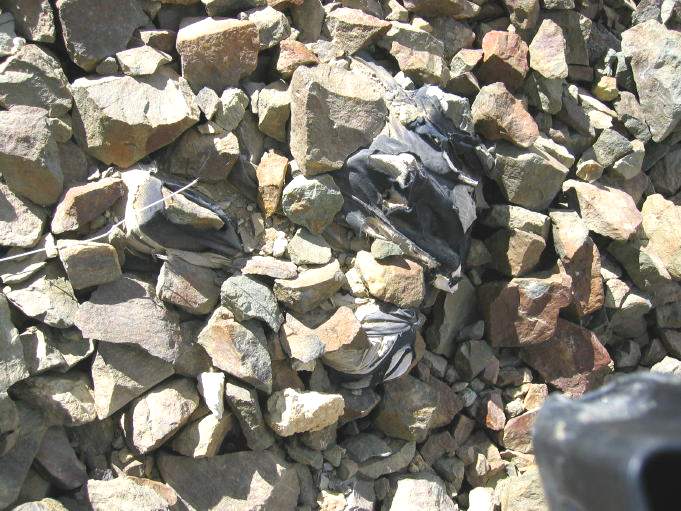


After photographing the propeller, Mario and I separated. I told him I would go check the peak to the North of the impact site. He went down. I didn’t tell him I meant the big 15,400’peak!
One big childhood dream remained for me. I was always fascinated by the story of Roberto Canessa and Nando Parrado (two of the survivors) breaching the Andes and reaching Chile to save everyone. In the book it describes how in three days they reached the top of the ridge facing west
and finally they got to see what was west. Their hope had been to see “the
green fields of Chile”. For more than 60 days everyone in the plane had
imagined that. When they finally reached the top of that ridge they were met with the horrible realization that they were in the middle of the Andes,
surrounded by snowy peaks, but somehow they found a way out. In the distance two pointy peaks without snow gave them hope. After walking a total of 10 days they reached a cattle post and were saved.
As a child, and more recently as a mountaineer, I had always wanted to know two things: Just how much distance and elevation did they have to cover? And what exactly was the view from that point? How would it look to a mountaineer?
We had gone up to the top of the ridge on the south. They had gone up to the top of the ridge on the west. Between where I was and where they were, there is a big peak. If I wanted to see what they saw, I had to climb that peak.
I was short on time, it was way past 5 o clock by then, but I decided to go for it. This was my chance! I followed the ridge. The ground had the strangest
consistency I have ever felt on a mountain. It was just like clay. I could actually sink my whole ice axe in the ground if I pushed it down. The ground
had a lot of moisture. Snow must have been covering this ridge recently. The climbing was straightforward except for a couple of spots. The first one was a short pitch of ice climbing. I had my crampons in my backpack but I was running against the clock.
The ice and hard snow provided just enough footholds so I went for it without crampons and with only one ice axe (two would have been nice here). Once on top of that ice ramp, I got that feeling that I hate…the feeling of “how am I gonna get down this?” “Well I’ll deal with it on my return.” Here I was, in a remote part of the Andes, alone, on a previously unclimbed peak, at 6 PM still trying to reach the summit, not knowing if the route would really go where I hoped it would. I was worried about returning and not finding the horses or Mario. I had just met the guy two days earlier. Would he get tired of waiting or get annoyed at my being so inconsiderate to leave him waiting for hours, getting cold with horses that haven’t eaten all day, wanting to go home? Would he leave me stranded in the same place as the survivors were?
How ironic would that be? Hey, after the day I was having anything seemed possible! But this was my chance to fulfill that dream, two days later I had a flight to the US and I couldn’t extend my trip any further.
I pushed on. Just below the summit I encountered a really steep and slippery frozen dirt slope. It was one of the most awkward things I’ve ever climbed. I had to use the
tip of my Ice axe, push it into the frozen ground to get any kind of solid hold. Crampons might have helped but by then it was 7 o’ clock and I had no time at all!
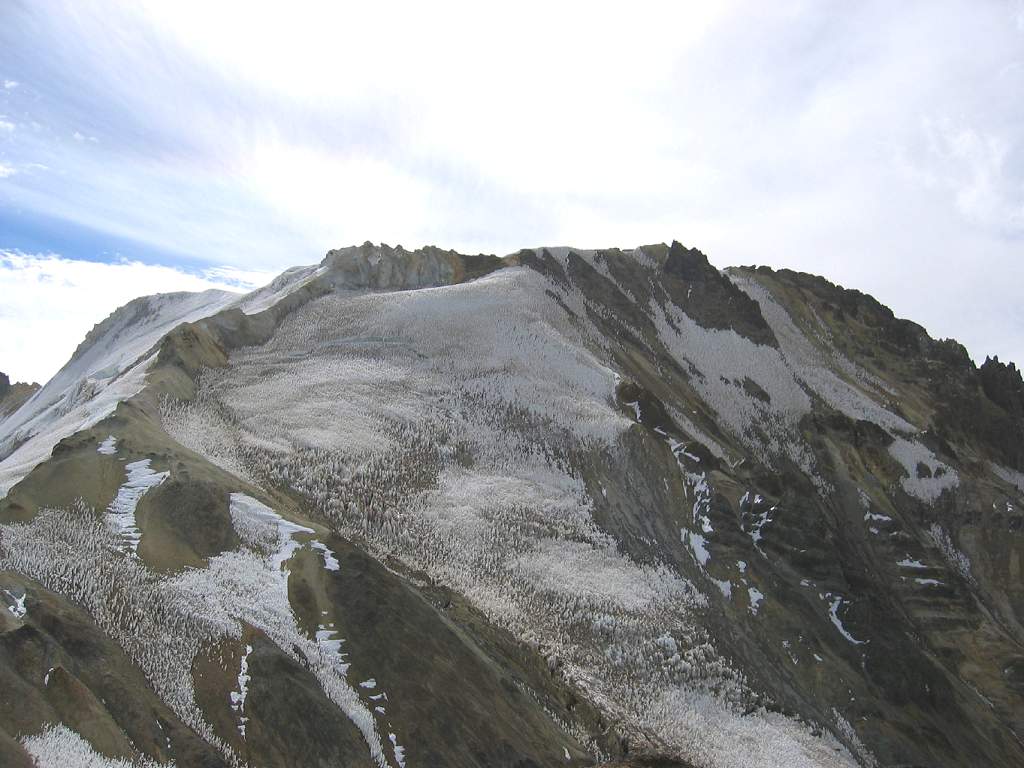
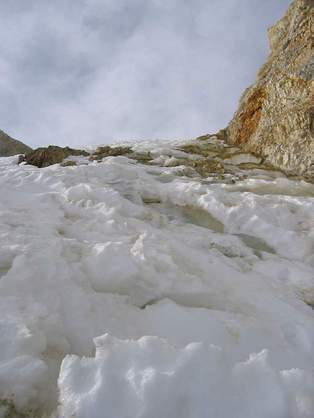
Finally the summit! And with it the view I had dreamed of for years….It did not disappoint! In front of me was a mountain reminiscent of Mont Blanc! Huge glaciers, snowy peaks to the right of that peak. A majestic feeling of being in the middle of the greatest mountain range in the world! Nando and Roberto must have wanted to die upon seeing this! For me it was incredibly exciting and impressive! It looked especially beautiful in the evening light. I can imagine what they must have felt! If they would have had to climb the peak in front of them they probably would have died, and with them the chances of the rest being rescued. But just like the book and the movie showed, they found hope in the distance.
As one looks to the left of that monstrous peak, one can see a Y and a very deep valley, and more to the left, way in the distance, there are, just like they described, two pointy peaks with no snow on them marking the end of the Andes.
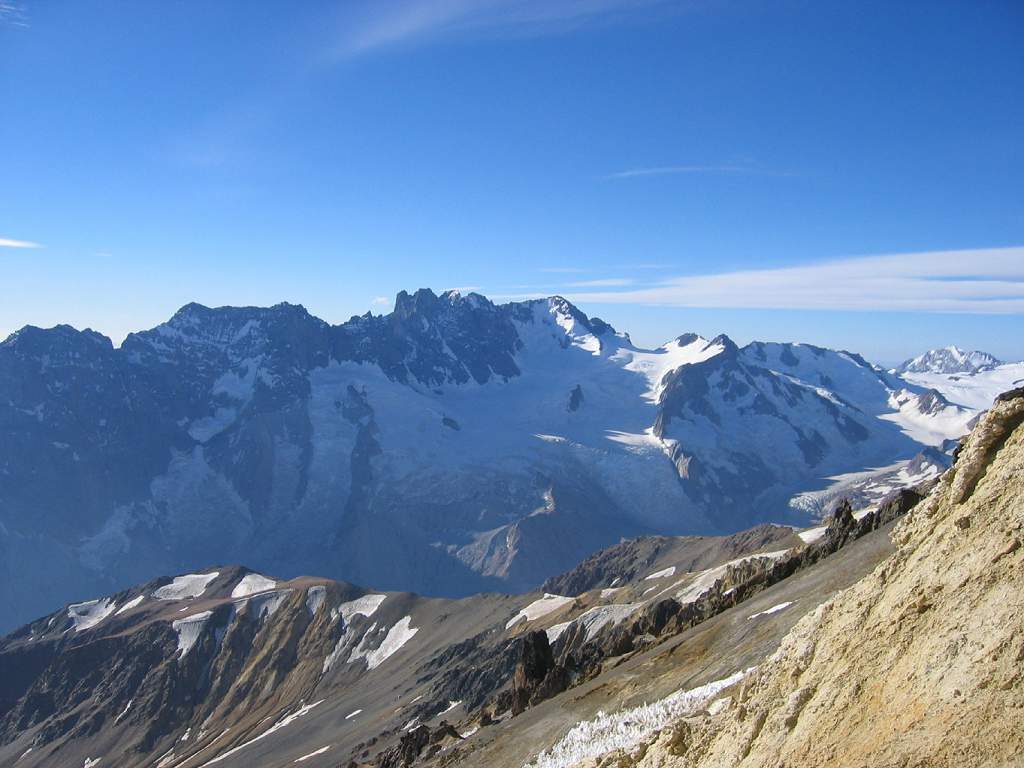
Beyond those peaks I could see the moist air forming clouds over those green valleys of Chile the boys were so desperately hoping to see but couldn’t. It must have taken an unbelievable amount of courage to go down into the unknown hoping there was a way out of the mountains, especially seeing how far they were from the end of the mountain range!
Even though I climbed and covered more distance in one day than Roberto and Nando had covered in three, to reach the saddle just north of where I was, my respect for their great accomplishment grew! I was fully aware that they were athletes but not mountaineers. They did not have any mountaineering gear or experience. They were climbing in rugby shoes and old fashioned skiing boots that probably didn’t fit so well, since they belonged to another one of the boys; plastic bags to protect their feet from the snow and cold; seat cushions cut up into snowshoes; and of course more than 60 days of malnourishment and being exposed to the elements at altitude! What they did was truly amazing!
I took photographs as fast as I could and turned around to descend. The sun was setting and I was at the top of a 15,400ft peak in the middle of the Andes!
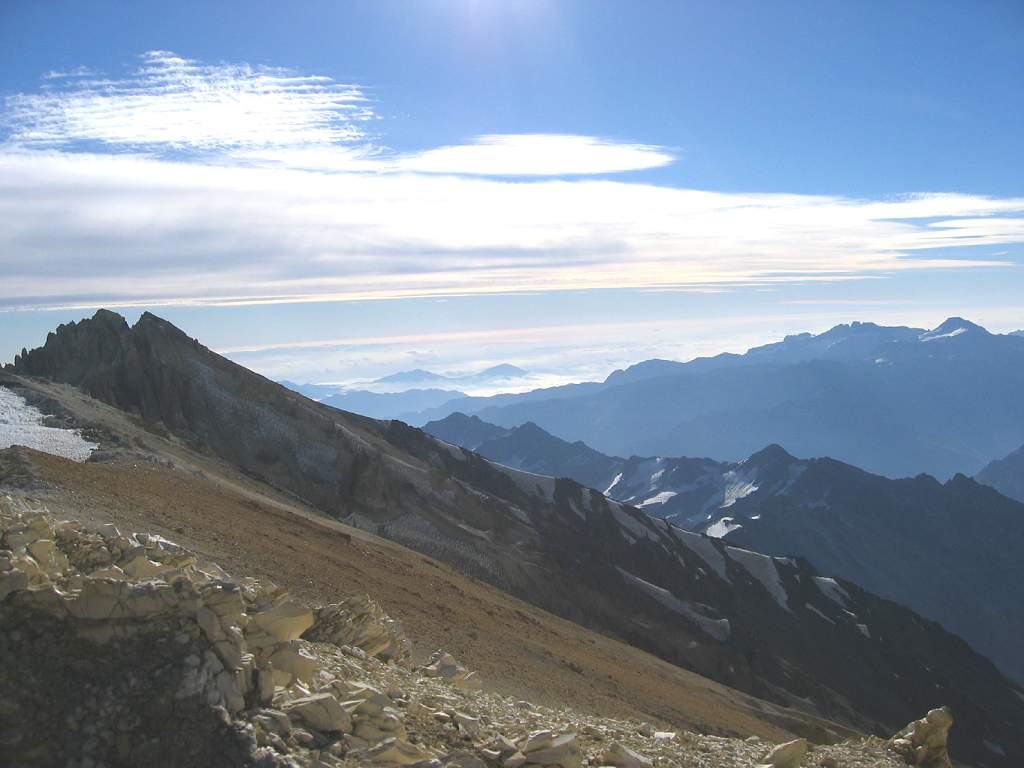
I moved as fast as I could as thoughts rushed through my head. Wouldn’t it be ironic if something happened to me? I had all the evidence of our discovery, photos, the “knife”, and Eduardo’s documents. If I fell into a crevasse or down the mountain Mario would have nothing to show for our discovery. Would everyone really believe such an unbelievable story? Eduardo would have never recovered his stuff. And no news would have been reported other than some Gringo or Mexican killed himself in the Andes. It was an interesting thought. More realistically, I was worried that I wouldn’t find anyone at the memorial site and would have to begin an epic of my own getting out of there.

As I made my way down I found an engine in the gully, which I quickly photographed and kept going. Lower on down the gully I started yelling Mario’s name in the hope that he would hear me and wait for me. At last I spotted him and he saw me, and to my delight I could see two horses!
As I reached Mario he handed me something to drink. I had been out of liquid for hours except for some water I had gotten from the melting glacier up above. I was worried he’d be furious with me for making him wait for hours in the cold. I told him what I climbed and he wasn’t angry. He was incredibly kind, given the circumstances. I ate some cookies he had, got on the horse, and we started the descent. As tired as I was, balancing myself on the horse, trotting and walking down such steep terrain in the dark proved to be agony for me. How I wished I knew how to ride a horse properly! My legs and back were killing me. By the time we made it down to the big river crossing there was no light whatsoever and, as we feared, the river had swelled quite a bit. We could hear big boulders being dragged by the river. Mario saved the day again! Somehow he found a good place to cross and timed it just right so that those rocks we were hearing wouldn’t hit our horses. A bit of luck too, I guess…
Late that night we arrived at our camp where everyone was glad to see us safe. The next day, after hours of horseback riding, four-wheeling, whitewater rafting (thrown in for fun) and driving, we arrived at Edgardo’s House in San Rafael where we showed him our discovery. “It’s like finding another part of the Titanic,” he said!
The next morning we called Eduardo Strauch. Edgardo said “Hey I’ve got some of your money here…” as he went on to describe our find. I talked to Eduardo, which was very exciting for me, and we said we’d be in touch so that I could share the photos with him and meet in person some day. I still remember his words… “I can’t believe this! I’m getting goose bumps just thinking about it…after 32 years!” I left the stuff with Edgardo so that he would get it to Eduardo.
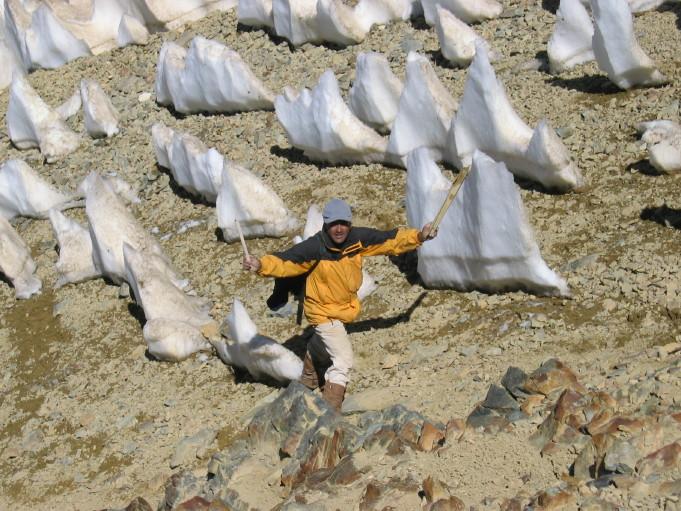
The next day I took a bus back to Mendoza; I picked up the rest of my gear from my Aconcagua expedition and headed for the airport. Then I found myself, as I checked my luggage, looking at my wallet, my glasses, my passport and my documents, as I was about to board the very same flight that Eduardo took 32 years earlier: The flight over the Andes leaving Mendoza to arrive at Santiago. They never made it, fortunately I did…
Written by Ricardo Peña, Boulder, Colorado, USA March 2005
Afterward (written on April 18, 2012)
The question I get asked a lot is: how did you get Eduardo’s belongings back to him?
As it turned out, Alvaro Mangino (another one of the 16 survivors) came with a group of friends to visit the site a week after I was there. Edgardo gave him Eduardo’s belongings and he gave them to Eduardo in Montevideo.
Weeks after my discovery I went to Mexico to guide the high volcanoes. While coming down from the mountains I found out that the news of this discovery had hit the media and it was now all over the world! Newspapers from every continent published the story of how one of the famous survivor’s wallet had been found in the mountains. Eduardo was bombarded by phone calls from the media. In his interviews he expressed interest in meeting me, the “Mexican alpinist who had found his belongings and generously returned them to him”. I was ecstatic! Through Edgardo I was able to email Eduardo and later that year we met in Mexico, on another one of my trips there, and a great friendship began which only grows with time. I can honestly say he is one of the closest friends I have ever had and I am truly honored how the Strauches treat me as if I was one more member of their family!

